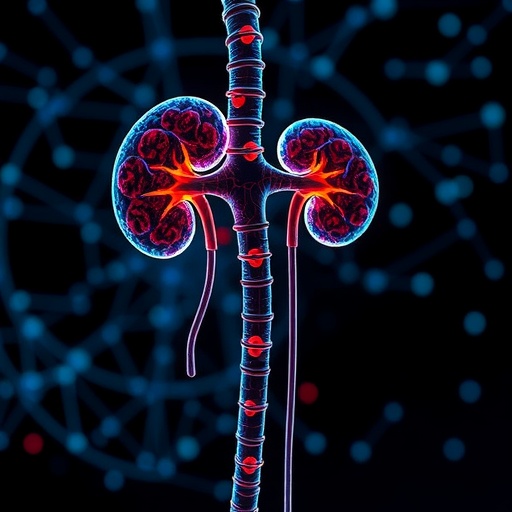The realm of regenerative medicine frequently thrives on the intricate interplay between organ systems, unveiling a cascade of biochemical and physiological responses that occur during organ transplantation. A recent commentary by Chen and Luo has attracted considerable attention in the medical community for its far-reaching implications in understanding acute kidney injury (AKI) following liver graft reperfusion. At the heart of their discussion lies a profound analysis of human kidney biopsies, which sheds light on the early manifestations of AKI post-transplantation, a vital area of research for optimizing patient outcomes.
The complexity of organ transplantation is not merely confined to the surgical process; it delves much deeper into the biological responses that take place. As the liver is reperfused, a series of metabolic changes trigger an immediate response from adjacent organs, particularly the kidneys. The proteomic analysis discussed by Chen and Luo offers a cutting-edge approach to elucidating these systemic responses, presenting an invaluable opportunity for researchers and clinicians alike to re-evaluate their strategies for managing organ transplant patients.
Among the many biochemical pathways at play during liver graft reperfusion, inflammatory processes take center stage. The reperfusion injury itself incites an inflammatory cascade that can compromise renal function, often leading to AKI. The comments put forth by Chen and Luo emphasize the need for a deeper understanding of these molecular mechanisms. By identifying specific biomarkers present in kidney biopsies, researchers have the potential to recognize patients at high risk for AKI much earlier in their recovery, allowing for timely intervention strategies.
Moreover, this innovative approach does not solely benefit clinicians; it lays the groundwork for future clinical trials focused on mitigating inflammation-related renal injuries. Chen and Luo argue that understanding the proteomic signatures associated with AKI will enable healthcare providers to develop targeted therapies that can potentially enhance kidney recovery after liver transplantation. Such advancements hold the promise of transforming patient management protocols, thus drastically improving outcomes in transplant populations.
The dialogue surrounding the proteomic analysis of kidney biopsies post-reperfusion also intersects with existing literature on the functionality of kidney cells under stress. Recent studies have emphasized the adaptability of renal tissues in response to ischemic conditions, suggesting that not all inflammatory responses result in irreversible damage. The nuances of kidney resilience might provide critical insights that could shape the interpretation of data derived from proteomics. This commentary draws our attention to the fact that while proteomic analysis is invaluable, it must be contextualized within the broader physiological spectrum of renal adaptability.
Chen and Luo’s commentary goes beyond merely presenting data; it reopens discussions about the potential repercussions of AKI not only on the kidneys but on the integrity of the entire transplant process. They suggest that AKI may serve as a broader indicator of graft dysfunction, thus urging for a multidisciplinary approach in managing liver transplant patients. This broadens the horizon for future research as it emphasizes the interconnectedness of organ systems and their collective responses during challenging medical situations.
The shift toward more integrative medical research heralds the advent of precision medicine in transplantation. Personalized approaches can arise from understanding both patient-specific factors and the universal biological responses, enabling tailored interventions that could preemptively address complications like AKI. The work by Chen and Luo supports this progressive outlook, advocating for collaborative efforts in translational medicine that link basic research with clinical application.
In exploring the future of patient care following liver transplants, the role of education cannot be understated. Awareness and education among medical professionals regarding the proteomic profiles associated with AKI could significantly influence clinical decision-making. As these insights translate into practice, they could lead to the establishment of standardized protocols that prioritize the early detection and management of renal complications, resulting in improved patient outcomes across the board.
The commentary by Chen and Luo also reinforces the necessity of long-term studies to track the effectiveness of proposed biomarkers in clinical scenarios. As the medical community embraces proteomic technology, validating these findings over time becomes paramount. Such longitudinal assessments will foster confidence in the utilization of identified biomarkers as indicators of AKI risk, ultimately refining the predictive capacity of clinical assessments in transplant medicine.
In conclusion, the commentary by Chen and Luo not only enhances our understanding of acute kidney injury following liver transplantation but also sets the stage for emerging advancements in the field. Their call to action resonates throughout the medical community, emphasizing the need for a multifaceted approach that combines acute care insights with innovative proteomic strategies. By collectively advancing our understanding of the biological responses during organ transplantation, we can improve patient care, outcomes, and the overall landscape of transplant medicine.
This pivotal moment in transplantation research validates the significance of an interdisciplinary approach that includes proteomics, clinical practice, and patient engagement. As researchers continue to unravel the complexities of organ reperfusion and its associated risks, the real winners will be the patients who stand to benefit from more effective, personalized medical interventions that could alter the course of transplant outcomes for years to come.
Subject of Research: Acute Kidney Injury After Liver Graft Reperfusion
Article Title: Comment to “Proteomic analysis of human kidney biopsies unveils emerging acute kidney injury very early after liver graft reperfusion”
Article References: Chen, T., Luo, T. Comment to “Proteomic analysis of human kidney biopsies unveils emerging acute kidney injury very early after liver graft reperfusion”.
J Transl Med 23, 1167 (2025). https://doi.org/10.1186/s12967-025-07205-8
Image Credits: AI Generated
DOI:
Keywords: Acute Kidney Injury, Liver Transplantation, Proteomic Analysis, Inflammatory Response, Renal Resilience, Precision Medicine.




